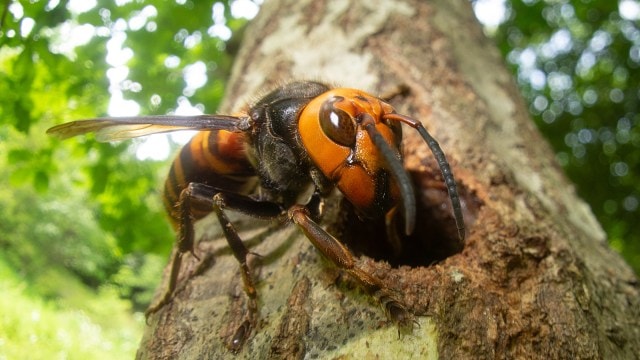📣 For more lifestyle news, click here to join our WhatsApp Channel and also follow us on Instagram
Meet the largest wasp in the world whose sting can actually kill a human
Scientifically known as Vespa mandarinia, the Asian giant hornet is native to parts of Asia, including Japan, China, Thailand, and South Korea, as well as the Russian Far East
 Get to know the Asian giant hornet, the world’s largest wasp whose sting can kill in rare cases. (Source: Wikimedia commons)
Get to know the Asian giant hornet, the world’s largest wasp whose sting can kill in rare cases. (Source: Wikimedia commons)You’re taking your morning walk, and then you see it: a wasp the size of your thumb, orange head gleaming in the sunlight, wings slicing the air. This isn’t just any insect. You’ve just encountered the Asian giant hornet, the largest and one of the most feared wasps on the planet.
Scientifically known as Vespa mandarinia, the Asian giant hornet is native to parts of Asia, including Japan, China, Thailand, and South Korea, as well as the Russian Far East. It’s often confused with other hornets or large wasps, but make no mistake, this species holds the crown for sheer size and sting power, and this is why:
- Body length: up to 5 centimetres (around 2 inches)
- Wingspan: up to 7.5 centimetres (3 inches)
- Stinger: approximately 6 millimetres long, and capable of piercing thick clothing
- Venom: strong enough to kill tissue and even lead to organ failure in rare cases
This insect earned a grim nickname in Japan: “murder hornet.” While the media exaggeration around that name isn’t always helpful, there’s truth in the danger it poses under certain conditions.
How dangerous is its sting?
One sting from an Asian giant hornet is incredibly painful, described by an entomologist to National Geographic as feeling like a hot nail being driven into the skin. That pain is due to a venom cocktail containing mandaratoxin, a powerful neurotoxin, as well as other tissue-destroying enzymes and chemicals that trigger intense inflammation.
Now here’s where it gets serious: while one sting is unlikely to be fatal for most healthy people, multiple stings can be deadly, especially if they cause anaphylaxis, a severe allergic reaction. Even without allergies, if someone is stung several times, like a farmer disturbing a nest, the venom can overwhelm the kidneys, nervous system, or heart. Fatal cases occur in Japan almost every year, with dozens of deaths reported annually, usually from multiple stings, according to the publication.
 One sting from an Asian giant hornet is incredibly painful (Source: Wikimedia commons)
One sting from an Asian giant hornet is incredibly painful (Source: Wikimedia commons)
How does it compare to other giant wasps?
There’s another contender in the “giant wasp” category: Megalara garuda, also nicknamed the King of Wasps. Discovered in Indonesia in 2012, this striking black insect can reach lengths of about 3.5 centimeters. What sets it apart are the absurdly long mandibles on the males, jaw-like structures almost as long as their front legs. Scientists believe they use these during mating rituals or to ward off rivals.
But here’s the thing: while Megalara garuda is large and looks fearsome, there’s little information about whether its sting is harmful to humans. No confirmed envenomation cases exist, so while it’s the largest species of wasp overall, it’s the Asian giant hornet that poses a real, known threat to humans.
What should you do if you encounter one of these wasps?
Thankfully, these hornets aren’t aggressive unless provoked. They won’t chase you down the street like a movie monster. But disturbing a nest, especially in wooded areas or under tree roots, can be dangerous.
If you’re travelling or hiking in areas where these hornets are native:
- Stay alert for low, loud buzzing sounds near the ground or trees
- Don’t swat or provoke them
- Back away slowly if you see one circling or acting aggressively
Despite the scary headlines and real risks, the Asian giant hornet isn’t some villain of the insect world. It plays an important ecological role, preying on pest insects and balancing ecosystems. The problem arises when it comes into contact with humans, or worse, spreads into areas like North America, where it becomes an invasive species, threatening local bee populations.
In 2019 and 2020, sightings in the US Pacific Northwest sparked concern and led to widespread media coverage. Local wildlife agencies acted quickly to trap and eliminate the nests to protect honeybee populations, essential for agriculture and the environment.
📣 For more lifestyle news, click here to join our WhatsApp Channel and also follow us on Instagram
- 01
- 02
- 03
- 04
- 05



























